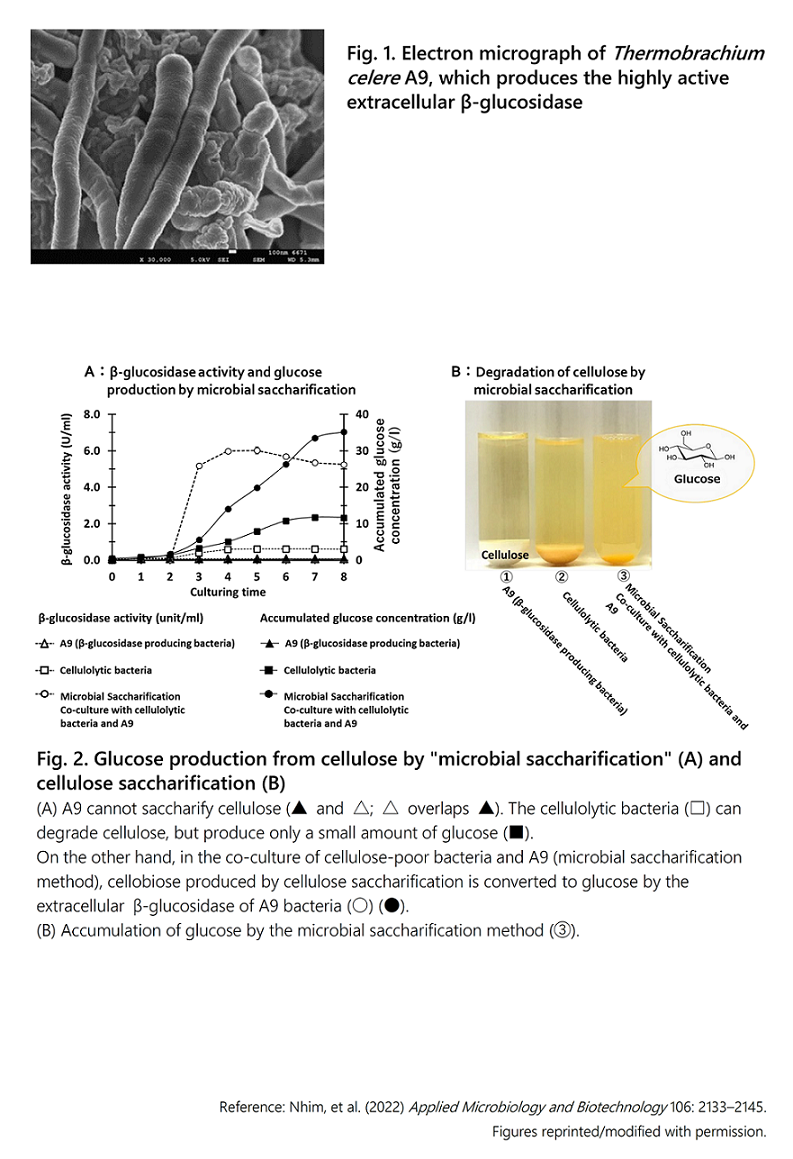Scalable Research Achievement
Technology development to saccharify cellulose “only by cultivating microorganisms" without using cellulase enzymes
Description
Cellulosic biomass, such as fiber and wastepaper discarded from our daily lives, is difficult to decompose in nature, and greenhouse gas emissions from the disposal and incineration of such cellulosic biomass are estimated to exceed 300 million metric tons worldwide. On the other hand, cellulosic biomass is the most abundant resource on earth, hence its effective utilization is required. Until now, its decomposition and saccharification have required large amounts of cellulase enzymes produced by fungi. However, cellulase enzymes are difficult to recycle and expensive to purchase, so there has been a need to reduce the cost of cellulase enzymes.
This report introduces the development of "microbial saccharification," an innovative saccharification technology that can produce glucose directly from cellulose using only microbial cultivation, by co-culturing the thermophilic anaerobic cellulolytic bacterium Clostridium thermocellum (hereinafter referred to as "cellulolytic bacteria") with bacteria that produce β-glucosidase, an enzyme that hydrolyzes cellobiose, the result of cellulose saccharification.
By screening with exelin, an artificial substrate, thermophilic anaerobic Thermobrachium celere A9 bacteria (NITE P-03454) (hereafter "A9"), which produce "β-glucosidase" outside the bacteria, are isolated from sewage sludge (Fig. 1). Cellulolytic bacteria use the cellobiose produced by cellulose saccharification, and since there is no β-glucosidase activity outside the bacteria, the cellobiose remains in the culture medium as cellobiose. On the other hand, the newly identified A9 cannot saccharify cellulose (Fig. 2A △ and ▲). A9 is a very rare bacterium that produces a potent extracellular β-glucosidase (Fig. 2A ○). The β-glucosidase produced by A9 converts cellobiose into glucose (Fig. 2A ●). As a result, cellulose is degraded with high efficiency, while glucose accumulates in the culture medium (Fig. 2B). This microbial saccharification method is thus an innovative technology that converts cellulose to glucose using only microbial culture without the use of cellulase enzymes.
Figure, table
- Research project
- Program name
- Term of research
-
FY2017–2022
- Responsible researcher
-
Kosugi Akihiko ( Biological Resources and Post-harvest Division )
Uke Ayaka ( Biological Resources and Post-harvest Division )
ORCID ID0000-0001-5077-8353Nhima Sreyneang ( King Mongkut's University of Technology Thonburi )
Waeonukul Rattiya ( King Mongkut's University of Technology Thonburi )
Baramee Sirilak ( King Mongkut's University of Technology Thonburi )
ORCID ID0000-0001-5122-2971Ratanakhanokchaia Khanok ( King Mongkut's University of Technology Thonburi )
Tachaapaikoon Chakrit ( King Mongkut's University of Technology Thonburi )
ORCID ID0000-0001-9795-2558Pason Patthra ( King Mongkut's University of Technology Thonburi )
- ほか
- Japanese PDF
-
2022_A06_ja.pdf930.78 KB
- English PDF
-
2022_A06_en.pdf538.61 KB
* Affiliation at the time of implementation of the study.

